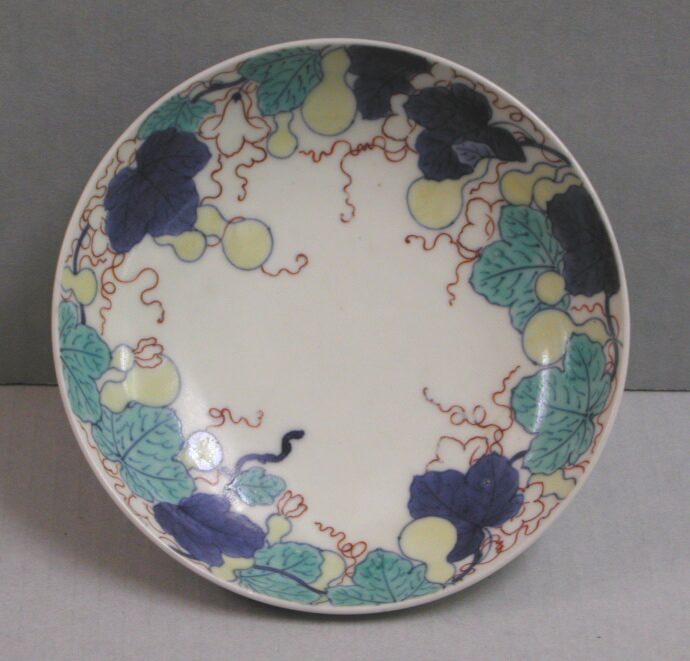Plate with gourd and vine design (one of five with 1964/1.100 and 102-104)
Artist Unknown, Nabeshima ware, Japan

Description
The Nabeshima kiln in northern Kyûshû, Japan, produced high quality porcelains, which the local governing family used as part of their annual tribute to the Tokugawa overlords. Reflecting the sophisticated taste of the military class, Nabeshima designs are elegant, intricate and witty. In this series of five plates, the artist uses several traditional seasonal motifs, but always with an unexpected twist.
Maribeth Graybill
“Four Seasons In Japanese Art”: Special Installation of Japanese Gallery at UMMA: Object Labels
July 5, 2003-January 4, 2004
The Nabeshima kiln in northern Kyûshû produced high-quality porcelains, which the local governing family used as part of its annual tribute to the Tokugawa shogun and other dignitaries. Reflecting the sophisticated taste of the samurai class, Nabeshima designs are elegant, witty, and replete with meaning.
The two plates are from a set of five in the museum collection. The right plate has the design of hanging gourds, a traditional motif in Japanese decorative arts. Here the circular shape is humorously incorporated into the overall design: the rim of the plate stands in for the vines from which the gourds are hanging. On the left plate, three jars are painted in an intentionally awkward manner with flat, patchwork-like patterns in order to evoke archaic designs.
(Label for UMMA Japanese Gallery Opening Rotation, March 2009)
Subject Matter:
The Nabeshima wares were used by the local governing family as part of their annual tribute to the Tokugawa overlords.
In this elegant but witty design, the rim of the plate is considered as a trills from which the gourds are hanging.
Physical Description:
The circular, smaller white porcelain plate has a design of gourds, flowers, vines and leaves around the rim. The gourds are outlined with blue underglaze and colored with yellow overglaze. Blue underglaze and transparent green overglaze are used for the leaves. The flowers and vines are drawn with red. The red enamel is worn off from some of the tendrils, a characteristic of 18th century Nabeshima. The reverse side has four clustered jewel or treasure motifs with four bows and streamers repeated three times. On the shallow foot, bold lines are drawn in a row like a comb. The design on the back is all drawn with blue underglaze. (Referencce: Becker, Sister Johanna. “A Group of Nabeshima Porcelain.")
Usage Rights:
If you are interested in using an image for a publication, please visit https://umma.umich.edu/request-image/ for more information and to fill out the online Image Rights and Reproductions Request Form.